Planning and Assessment for Teaching and Learning: A Report
VerifiedAdded on 2023/01/11
|8
|2693
|59
Report
AI Summary
This report delves into the core aspects of early childhood education, exploring curriculum positions, theories, and various approaches to curriculum development. It examines the importance of early childhood experiences in shaping a child's future, focusing on the cognitive learning process and the influence of the learning environment. The report discusses policy guidelines, children's learning processes, and curriculum goals, emphasizing the significance of integrated learning and the development of essential skills. It also outlines pedagogical approaches, such as a letter-connecting activity, to enhance children's learning experiences. The report concludes by highlighting the significance of early childhood education for children's overall development and the importance of proper planning and assessment to ensure effective learning outcomes.
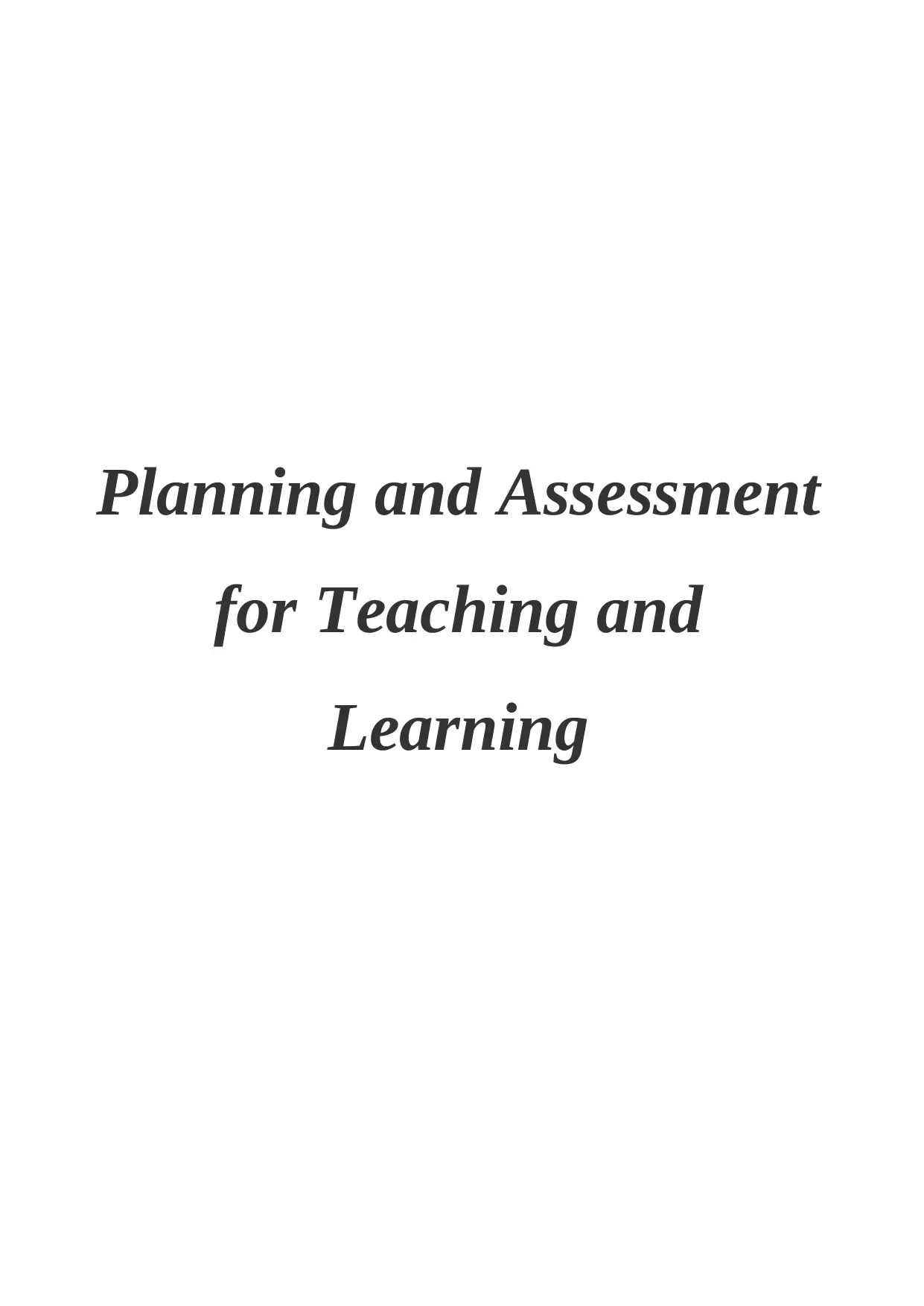
Planning and Assessment
for Teaching and
Learning
for Teaching and
Learning
Paraphrase This Document
Need a fresh take? Get an instant paraphrase of this document with our AI Paraphraser
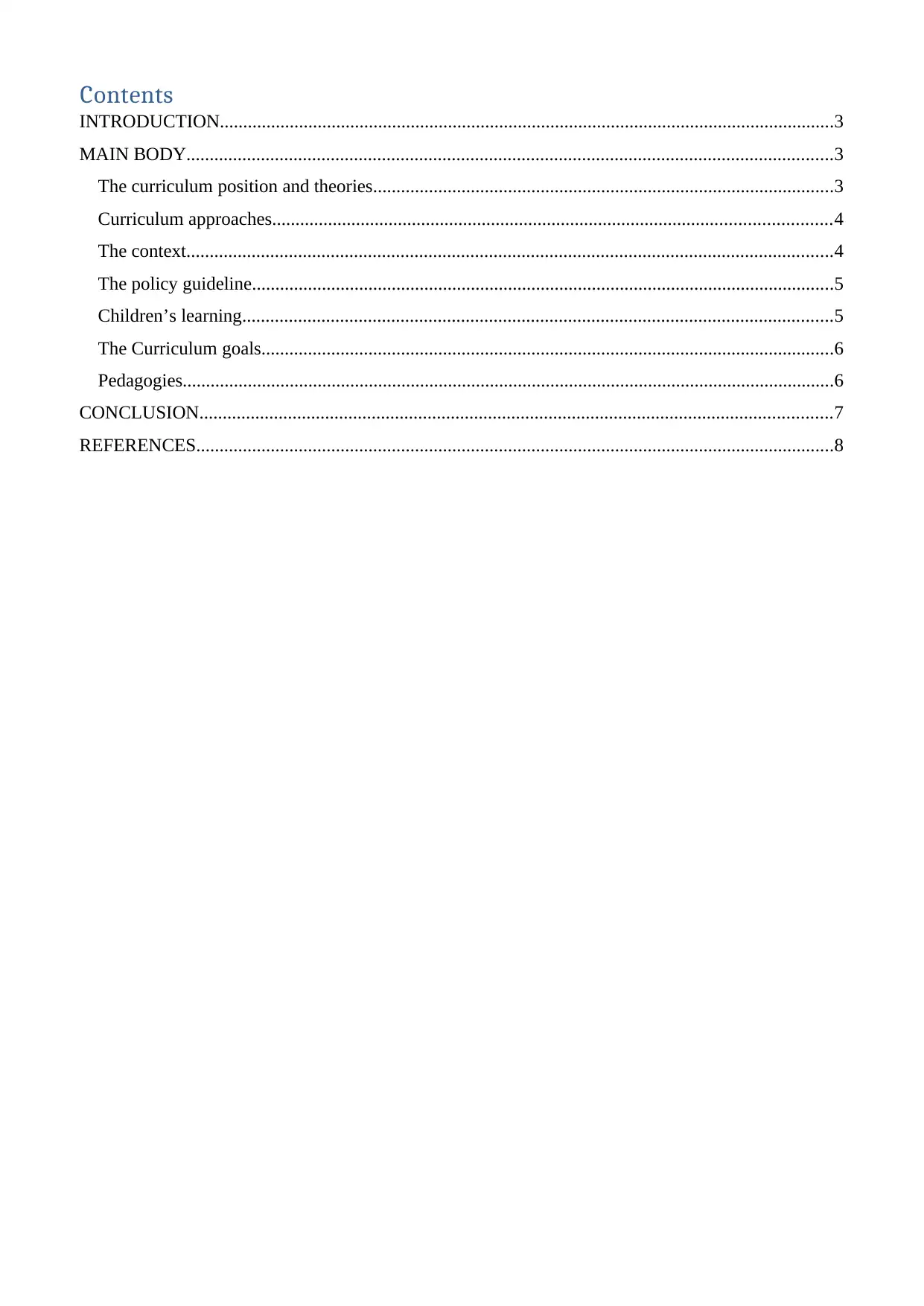
Contents
INTRODUCTION....................................................................................................................................3
MAIN BODY...........................................................................................................................................3
The curriculum position and theories...................................................................................................3
Curriculum approaches........................................................................................................................4
The context...........................................................................................................................................4
The policy guideline.............................................................................................................................5
Children’s learning...............................................................................................................................5
The Curriculum goals...........................................................................................................................6
Pedagogies............................................................................................................................................6
CONCLUSION........................................................................................................................................7
REFERENCES.........................................................................................................................................8
INTRODUCTION....................................................................................................................................3
MAIN BODY...........................................................................................................................................3
The curriculum position and theories...................................................................................................3
Curriculum approaches........................................................................................................................4
The context...........................................................................................................................................4
The policy guideline.............................................................................................................................5
Children’s learning...............................................................................................................................5
The Curriculum goals...........................................................................................................................6
Pedagogies............................................................................................................................................6
CONCLUSION........................................................................................................................................7
REFERENCES.........................................................................................................................................8
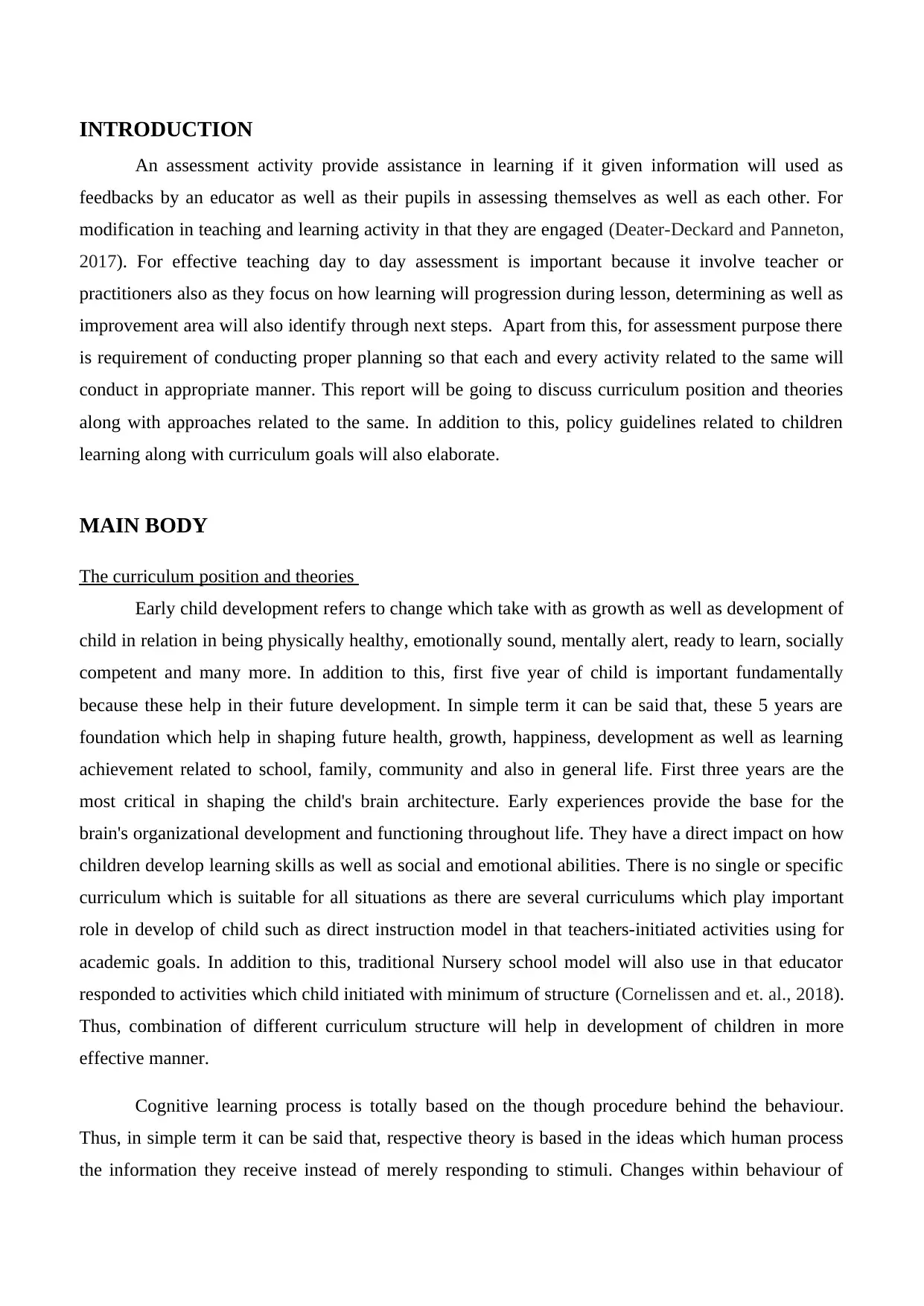
INTRODUCTION
An assessment activity provide assistance in learning if it given information will used as
feedbacks by an educator as well as their pupils in assessing themselves as well as each other. For
modification in teaching and learning activity in that they are engaged (Deater-Deckard and Panneton,
2017). For effective teaching day to day assessment is important because it involve teacher or
practitioners also as they focus on how learning will progression during lesson, determining as well as
improvement area will also identify through next steps. Apart from this, for assessment purpose there
is requirement of conducting proper planning so that each and every activity related to the same will
conduct in appropriate manner. This report will be going to discuss curriculum position and theories
along with approaches related to the same. In addition to this, policy guidelines related to children
learning along with curriculum goals will also elaborate.
MAIN BODY
The curriculum position and theories
Early child development refers to change which take with as growth as well as development of
child in relation in being physically healthy, emotionally sound, mentally alert, ready to learn, socially
competent and many more. In addition to this, first five year of child is important fundamentally
because these help in their future development. In simple term it can be said that, these 5 years are
foundation which help in shaping future health, growth, happiness, development as well as learning
achievement related to school, family, community and also in general life. First three years are the
most critical in shaping the child's brain architecture. Early experiences provide the base for the
brain's organizational development and functioning throughout life. They have a direct impact on how
children develop learning skills as well as social and emotional abilities. There is no single or specific
curriculum which is suitable for all situations as there are several curriculums which play important
role in develop of child such as direct instruction model in that teachers-initiated activities using for
academic goals. In addition to this, traditional Nursery school model will also use in that educator
responded to activities which child initiated with minimum of structure (Cornelissen and et. al., 2018).
Thus, combination of different curriculum structure will help in development of children in more
effective manner.
Cognitive learning process is totally based on the though procedure behind the behaviour.
Thus, in simple term it can be said that, respective theory is based in the ideas which human process
the information they receive instead of merely responding to stimuli. Changes within behaviour of
An assessment activity provide assistance in learning if it given information will used as
feedbacks by an educator as well as their pupils in assessing themselves as well as each other. For
modification in teaching and learning activity in that they are engaged (Deater-Deckard and Panneton,
2017). For effective teaching day to day assessment is important because it involve teacher or
practitioners also as they focus on how learning will progression during lesson, determining as well as
improvement area will also identify through next steps. Apart from this, for assessment purpose there
is requirement of conducting proper planning so that each and every activity related to the same will
conduct in appropriate manner. This report will be going to discuss curriculum position and theories
along with approaches related to the same. In addition to this, policy guidelines related to children
learning along with curriculum goals will also elaborate.
MAIN BODY
The curriculum position and theories
Early child development refers to change which take with as growth as well as development of
child in relation in being physically healthy, emotionally sound, mentally alert, ready to learn, socially
competent and many more. In addition to this, first five year of child is important fundamentally
because these help in their future development. In simple term it can be said that, these 5 years are
foundation which help in shaping future health, growth, happiness, development as well as learning
achievement related to school, family, community and also in general life. First three years are the
most critical in shaping the child's brain architecture. Early experiences provide the base for the
brain's organizational development and functioning throughout life. They have a direct impact on how
children develop learning skills as well as social and emotional abilities. There is no single or specific
curriculum which is suitable for all situations as there are several curriculums which play important
role in develop of child such as direct instruction model in that teachers-initiated activities using for
academic goals. In addition to this, traditional Nursery school model will also use in that educator
responded to activities which child initiated with minimum of structure (Cornelissen and et. al., 2018).
Thus, combination of different curriculum structure will help in development of children in more
effective manner.
Cognitive learning process is totally based on the though procedure behind the behaviour.
Thus, in simple term it can be said that, respective theory is based in the ideas which human process
the information they receive instead of merely responding to stimuli. Changes within behaviour of
⊘ This is a preview!⊘
Do you want full access?
Subscribe today to unlock all pages.

Trusted by 1+ million students worldwide
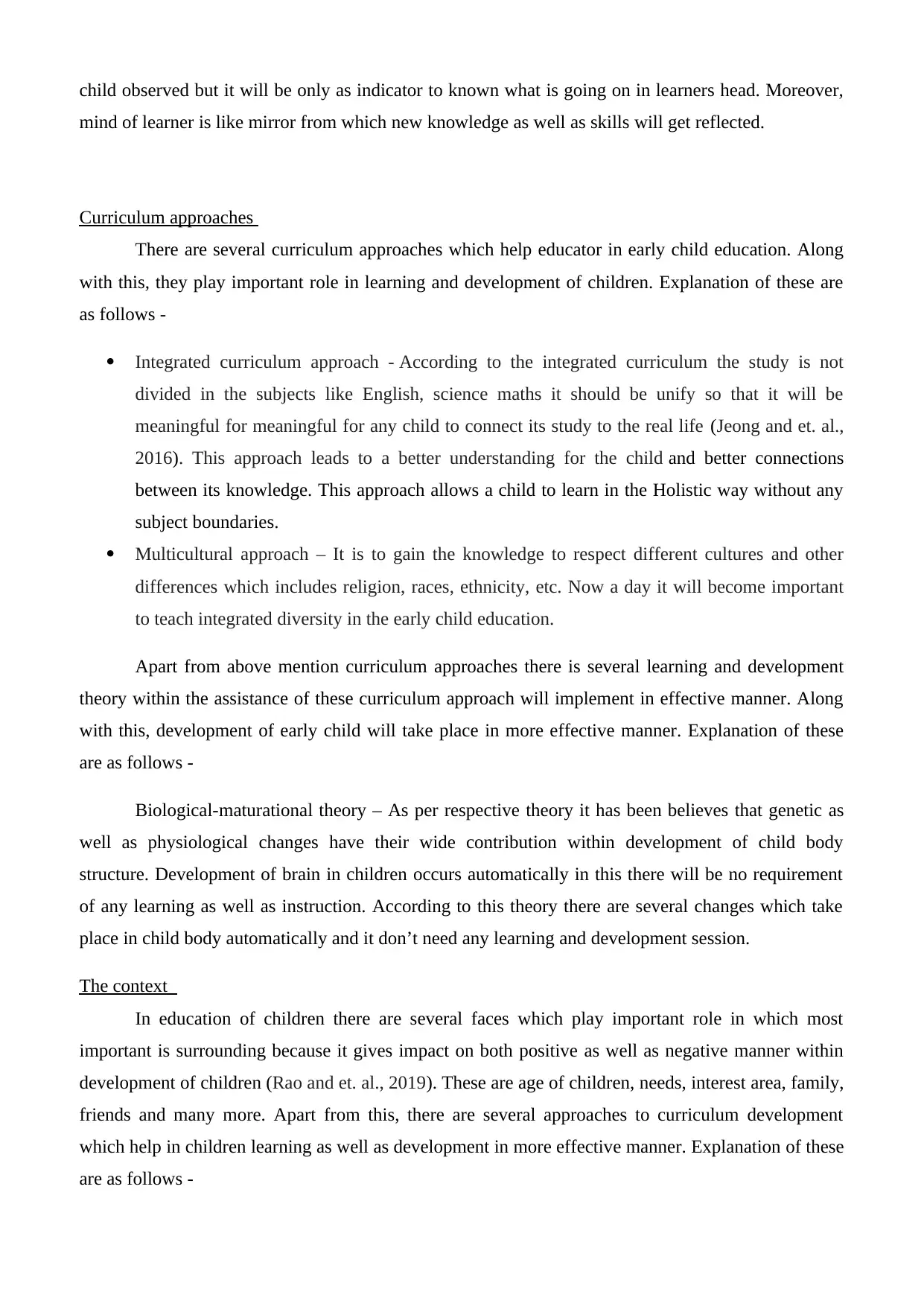
child observed but it will be only as indicator to known what is going on in learners head. Moreover,
mind of learner is like mirror from which new knowledge as well as skills will get reflected.
Curriculum approaches
There are several curriculum approaches which help educator in early child education. Along
with this, they play important role in learning and development of children. Explanation of these are
as follows -
Integrated curriculum approach - According to the integrated curriculum the study is not
divided in the subjects like English, science maths it should be unify so that it will be
meaningful for meaningful for any child to connect its study to the real life (Jeong and et. al.,
2016). This approach leads to a better understanding for the child and better connections
between its knowledge. This approach allows a child to learn in the Holistic way without any
subject boundaries.
Multicultural approach – It is to gain the knowledge to respect different cultures and other
differences which includes religion, races, ethnicity, etc. Now a day it will become important
to teach integrated diversity in the early child education.
Apart from above mention curriculum approaches there is several learning and development
theory within the assistance of these curriculum approach will implement in effective manner. Along
with this, development of early child will take place in more effective manner. Explanation of these
are as follows -
Biological-maturational theory – As per respective theory it has been believes that genetic as
well as physiological changes have their wide contribution within development of child body
structure. Development of brain in children occurs automatically in this there will be no requirement
of any learning as well as instruction. According to this theory there are several changes which take
place in child body automatically and it don’t need any learning and development session.
The context
In education of children there are several faces which play important role in which most
important is surrounding because it gives impact on both positive as well as negative manner within
development of children (Rao and et. al., 2019). These are age of children, needs, interest area, family,
friends and many more. Apart from this, there are several approaches to curriculum development
which help in children learning as well as development in more effective manner. Explanation of these
are as follows -
mind of learner is like mirror from which new knowledge as well as skills will get reflected.
Curriculum approaches
There are several curriculum approaches which help educator in early child education. Along
with this, they play important role in learning and development of children. Explanation of these are
as follows -
Integrated curriculum approach - According to the integrated curriculum the study is not
divided in the subjects like English, science maths it should be unify so that it will be
meaningful for meaningful for any child to connect its study to the real life (Jeong and et. al.,
2016). This approach leads to a better understanding for the child and better connections
between its knowledge. This approach allows a child to learn in the Holistic way without any
subject boundaries.
Multicultural approach – It is to gain the knowledge to respect different cultures and other
differences which includes religion, races, ethnicity, etc. Now a day it will become important
to teach integrated diversity in the early child education.
Apart from above mention curriculum approaches there is several learning and development
theory within the assistance of these curriculum approach will implement in effective manner. Along
with this, development of early child will take place in more effective manner. Explanation of these
are as follows -
Biological-maturational theory – As per respective theory it has been believes that genetic as
well as physiological changes have their wide contribution within development of child body
structure. Development of brain in children occurs automatically in this there will be no requirement
of any learning as well as instruction. According to this theory there are several changes which take
place in child body automatically and it don’t need any learning and development session.
The context
In education of children there are several faces which play important role in which most
important is surrounding because it gives impact on both positive as well as negative manner within
development of children (Rao and et. al., 2019). These are age of children, needs, interest area, family,
friends and many more. Apart from this, there are several approaches to curriculum development
which help in children learning as well as development in more effective manner. Explanation of these
are as follows -
Paraphrase This Document
Need a fresh take? Get an instant paraphrase of this document with our AI Paraphraser
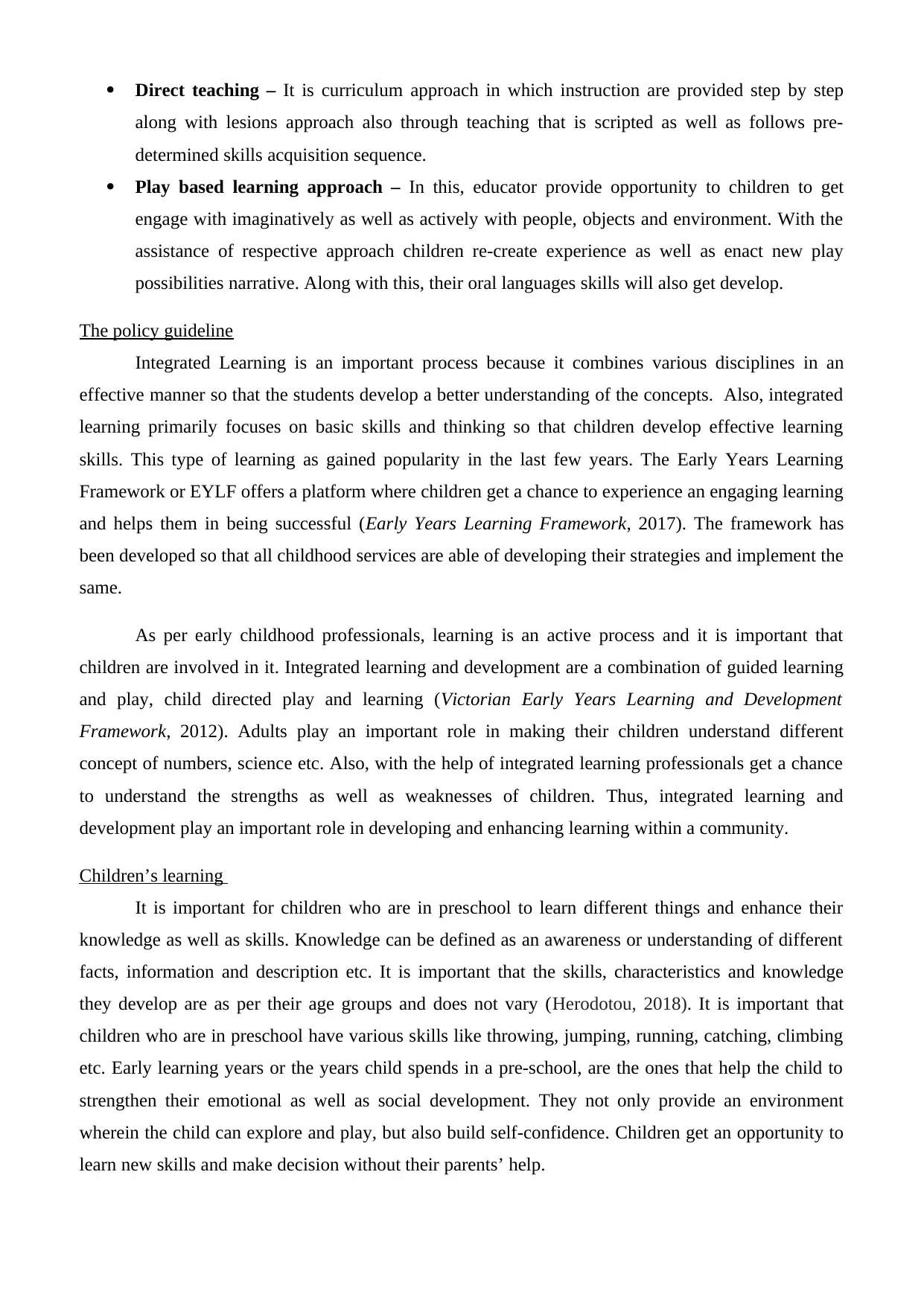
Direct teaching – It is curriculum approach in which instruction are provided step by step
along with lesions approach also through teaching that is scripted as well as follows pre-
determined skills acquisition sequence.
Play based learning approach – In this, educator provide opportunity to children to get
engage with imaginatively as well as actively with people, objects and environment. With the
assistance of respective approach children re-create experience as well as enact new play
possibilities narrative. Along with this, their oral languages skills will also get develop.
The policy guideline
Integrated Learning is an important process because it combines various disciplines in an
effective manner so that the students develop a better understanding of the concepts. Also, integrated
learning primarily focuses on basic skills and thinking so that children develop effective learning
skills. This type of learning as gained popularity in the last few years. The Early Years Learning
Framework or EYLF offers a platform where children get a chance to experience an engaging learning
and helps them in being successful (Early Years Learning Framework, 2017). The framework has
been developed so that all childhood services are able of developing their strategies and implement the
same.
As per early childhood professionals, learning is an active process and it is important that
children are involved in it. Integrated learning and development are a combination of guided learning
and play, child directed play and learning (Victorian Early Years Learning and Development
Framework, 2012). Adults play an important role in making their children understand different
concept of numbers, science etc. Also, with the help of integrated learning professionals get a chance
to understand the strengths as well as weaknesses of children. Thus, integrated learning and
development play an important role in developing and enhancing learning within a community.
Children’s learning
It is important for children who are in preschool to learn different things and enhance their
knowledge as well as skills. Knowledge can be defined as an awareness or understanding of different
facts, information and description etc. It is important that the skills, characteristics and knowledge
they develop are as per their age groups and does not vary (Herodotou, 2018). It is important that
children who are in preschool have various skills like throwing, jumping, running, catching, climbing
etc. Early learning years or the years child spends in a pre-school, are the ones that help the child to
strengthen their emotional as well as social development. They not only provide an environment
wherein the child can explore and play, but also build self-confidence. Children get an opportunity to
learn new skills and make decision without their parents’ help.
along with lesions approach also through teaching that is scripted as well as follows pre-
determined skills acquisition sequence.
Play based learning approach – In this, educator provide opportunity to children to get
engage with imaginatively as well as actively with people, objects and environment. With the
assistance of respective approach children re-create experience as well as enact new play
possibilities narrative. Along with this, their oral languages skills will also get develop.
The policy guideline
Integrated Learning is an important process because it combines various disciplines in an
effective manner so that the students develop a better understanding of the concepts. Also, integrated
learning primarily focuses on basic skills and thinking so that children develop effective learning
skills. This type of learning as gained popularity in the last few years. The Early Years Learning
Framework or EYLF offers a platform where children get a chance to experience an engaging learning
and helps them in being successful (Early Years Learning Framework, 2017). The framework has
been developed so that all childhood services are able of developing their strategies and implement the
same.
As per early childhood professionals, learning is an active process and it is important that
children are involved in it. Integrated learning and development are a combination of guided learning
and play, child directed play and learning (Victorian Early Years Learning and Development
Framework, 2012). Adults play an important role in making their children understand different
concept of numbers, science etc. Also, with the help of integrated learning professionals get a chance
to understand the strengths as well as weaknesses of children. Thus, integrated learning and
development play an important role in developing and enhancing learning within a community.
Children’s learning
It is important for children who are in preschool to learn different things and enhance their
knowledge as well as skills. Knowledge can be defined as an awareness or understanding of different
facts, information and description etc. It is important that the skills, characteristics and knowledge
they develop are as per their age groups and does not vary (Herodotou, 2018). It is important that
children who are in preschool have various skills like throwing, jumping, running, catching, climbing
etc. Early learning years or the years child spends in a pre-school, are the ones that help the child to
strengthen their emotional as well as social development. They not only provide an environment
wherein the child can explore and play, but also build self-confidence. Children get an opportunity to
learn new skills and make decision without their parents’ help.

There are various processes that children develop in their early years include learning a
language and communicate with others through reading, writing as well as talking. Children learn how
to interact with each other and build positive relationships. Preschools help children in expressing the
way how they feel with each other like happy, sad, joyful etc. Thus, it can be said that preschool
learning forms the base of what children learn and the reason I chose these learning outcomes is
because they are realistic, achievable as well as specific (Black and et. al., 2019). Also, researches
have shown that children not only need to develop knowledge that is universally established but also
other facts and rules that are appropriate for their socio-cultural environment.
The Curriculum goals
To ensure that children achieve their respective learning outcomes, it is necessary that teachers
support the way in which children learn different approaches to collaborating with their peers. It is
also important that the teach becomes familiar with the ways by which children communicate and
express their feelings to develop relationships with the peers. The main reason behind why these goals
are designed is to help the teachers understand the different ways in which children interact because
every child has a different way of communicating his/her thoughts as well as feelings. Thus, the goas
make sure that the ways are properly understood by the teacher without any confusion.
Pedagogies
A project is not alone but comprises of various activities and the learning activity chosen for
this report is connecting the dots with letters. The activity will be started by introducing letters to the
children and the teacher will get to know the way every child perceives the same and implements it.
The letters will be taught gradually, for example- three to four letters will be taught each day for a
week. Revision will be taken alongside. Once the letters are introduced to the children and they are
familiar with the letters, respective activity will be carried out (Niklas and Schneider, 2017). It will
also be ensured that all children participate in the activity and that no one is left out. The activity will
be completed in two sessions and will include various resources like pencil, paper, colours etc. Usage
of colours will ensure that the children are engaged in the same.
The activity will help the children in learning various new techniques and understanding the
difference between colours. Alphabet learning will be done this way in a very creative manner so that
the children are not only engaged in the same, but also enjoy being a part of it. Along with this, things
starting from the letter as well as their pronunciation will also be taught so that a better learning
environment is created. The teacher will be there to help in case any child needs support or is facing
difficulty in understanding the letters. Other resources that will be required for the activity to be
carried out smoothly will be a white board as well as colourful markers so that the teacher can explain
the formation and pronunciation of each letter in a much more effective and efficient way.
language and communicate with others through reading, writing as well as talking. Children learn how
to interact with each other and build positive relationships. Preschools help children in expressing the
way how they feel with each other like happy, sad, joyful etc. Thus, it can be said that preschool
learning forms the base of what children learn and the reason I chose these learning outcomes is
because they are realistic, achievable as well as specific (Black and et. al., 2019). Also, researches
have shown that children not only need to develop knowledge that is universally established but also
other facts and rules that are appropriate for their socio-cultural environment.
The Curriculum goals
To ensure that children achieve their respective learning outcomes, it is necessary that teachers
support the way in which children learn different approaches to collaborating with their peers. It is
also important that the teach becomes familiar with the ways by which children communicate and
express their feelings to develop relationships with the peers. The main reason behind why these goals
are designed is to help the teachers understand the different ways in which children interact because
every child has a different way of communicating his/her thoughts as well as feelings. Thus, the goas
make sure that the ways are properly understood by the teacher without any confusion.
Pedagogies
A project is not alone but comprises of various activities and the learning activity chosen for
this report is connecting the dots with letters. The activity will be started by introducing letters to the
children and the teacher will get to know the way every child perceives the same and implements it.
The letters will be taught gradually, for example- three to four letters will be taught each day for a
week. Revision will be taken alongside. Once the letters are introduced to the children and they are
familiar with the letters, respective activity will be carried out (Niklas and Schneider, 2017). It will
also be ensured that all children participate in the activity and that no one is left out. The activity will
be completed in two sessions and will include various resources like pencil, paper, colours etc. Usage
of colours will ensure that the children are engaged in the same.
The activity will help the children in learning various new techniques and understanding the
difference between colours. Alphabet learning will be done this way in a very creative manner so that
the children are not only engaged in the same, but also enjoy being a part of it. Along with this, things
starting from the letter as well as their pronunciation will also be taught so that a better learning
environment is created. The teacher will be there to help in case any child needs support or is facing
difficulty in understanding the letters. Other resources that will be required for the activity to be
carried out smoothly will be a white board as well as colourful markers so that the teacher can explain
the formation and pronunciation of each letter in a much more effective and efficient way.
⊘ This is a preview!⊘
Do you want full access?
Subscribe today to unlock all pages.

Trusted by 1+ million students worldwide
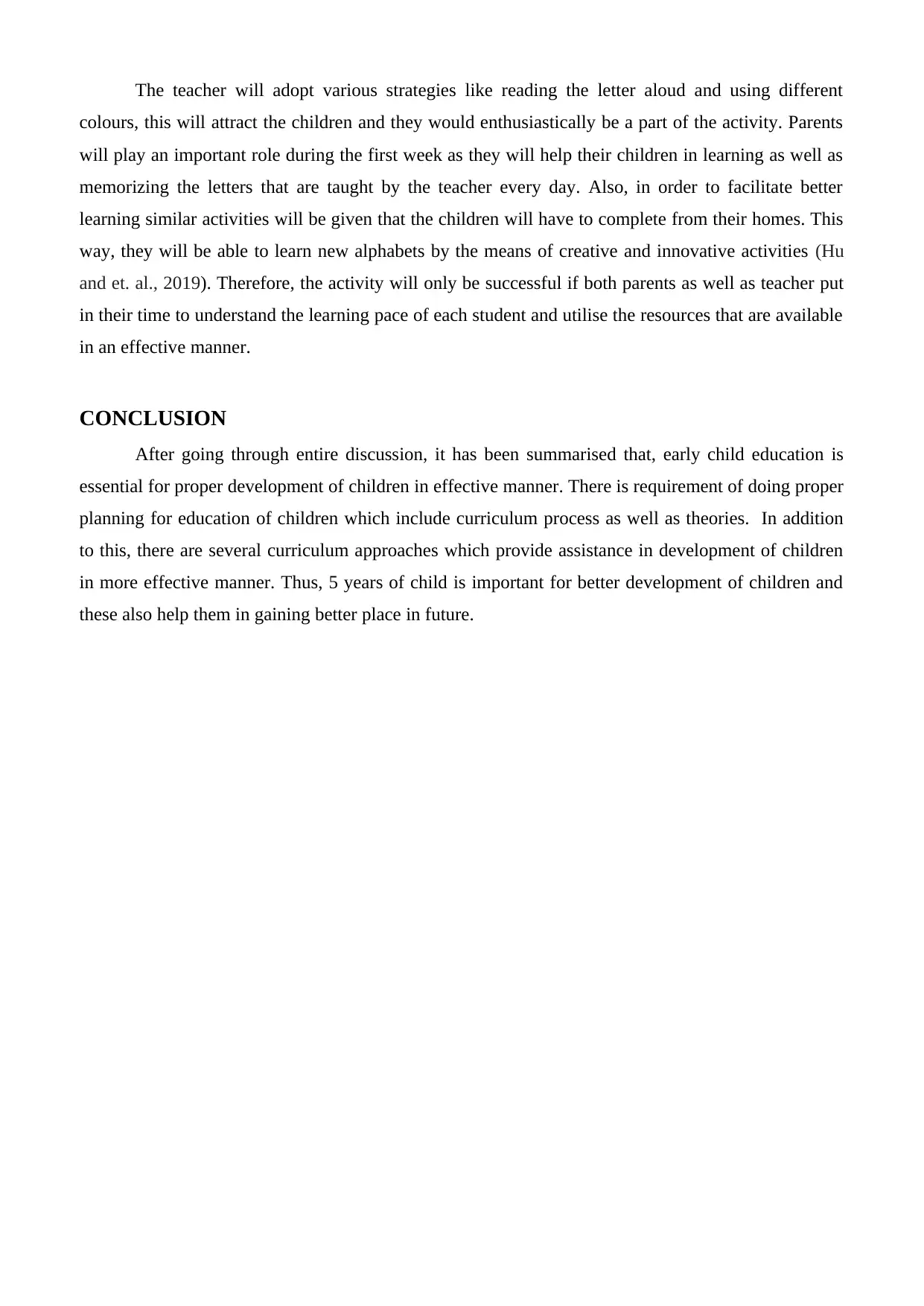
The teacher will adopt various strategies like reading the letter aloud and using different
colours, this will attract the children and they would enthusiastically be a part of the activity. Parents
will play an important role during the first week as they will help their children in learning as well as
memorizing the letters that are taught by the teacher every day. Also, in order to facilitate better
learning similar activities will be given that the children will have to complete from their homes. This
way, they will be able to learn new alphabets by the means of creative and innovative activities (Hu
and et. al., 2019). Therefore, the activity will only be successful if both parents as well as teacher put
in their time to understand the learning pace of each student and utilise the resources that are available
in an effective manner.
CONCLUSION
After going through entire discussion, it has been summarised that, early child education is
essential for proper development of children in effective manner. There is requirement of doing proper
planning for education of children which include curriculum process as well as theories. In addition
to this, there are several curriculum approaches which provide assistance in development of children
in more effective manner. Thus, 5 years of child is important for better development of children and
these also help them in gaining better place in future.
colours, this will attract the children and they would enthusiastically be a part of the activity. Parents
will play an important role during the first week as they will help their children in learning as well as
memorizing the letters that are taught by the teacher every day. Also, in order to facilitate better
learning similar activities will be given that the children will have to complete from their homes. This
way, they will be able to learn new alphabets by the means of creative and innovative activities (Hu
and et. al., 2019). Therefore, the activity will only be successful if both parents as well as teacher put
in their time to understand the learning pace of each student and utilise the resources that are available
in an effective manner.
CONCLUSION
After going through entire discussion, it has been summarised that, early child education is
essential for proper development of children in effective manner. There is requirement of doing proper
planning for education of children which include curriculum process as well as theories. In addition
to this, there are several curriculum approaches which provide assistance in development of children
in more effective manner. Thus, 5 years of child is important for better development of children and
these also help them in gaining better place in future.
Paraphrase This Document
Need a fresh take? Get an instant paraphrase of this document with our AI Paraphraser

REFERENCES
Books and Journals
Black, M. and et. al., 2019. Learning across the UK: a review of public health systems and policy
approaches to early child development since political devolution. Journal of Public Health.
Cornelissen, T. and et. al., 2018. Who benefits from universal child care? Estimating marginal returns
to early child care attendance. Journal of Political Economy. 126(6). Pp.2356-2409.
Deater-Deckard, K. D. and Panneton, R., 2017. Parental stress and early child development. Springer.
Herodotou, C., 2018. Young children and tablets: A systematic review of effects on learning and
development. Journal of Computer Assisted Learning. 34(1). Pp.1-9.
Hu, B. Y. And et. al., 2019. Contributions of Teacher–Child Interaction Quality to Chinese Children’s
Development in the Early Childhood Years. Early Education and Development. 30(2). Pp.159-
177.
Jeong, J. And et. al., 2016. Paternal stimulation and early child development in low-and middle-
income countries. Pediatrics. 138(4). P.e20161357.
Jeong, J., McCoy, D. C. and Fink, G., 2017. Pathways between paternal and maternal education,
caregivers’ support for learning, and early child development in 44 low-and middle-income
countries. Early Childhood Research Quarterly. 41. Pp.136-148.
Luo, R. and et. al., 2019. Passive parenting and its association with early child development. Early
Child Development and Care. 189(10). Pp.1709-1723.
Nguyen, P. H. and et. al., 2018. Influences of early child nutritional status and home learning
environment on child development in Vietnam. Maternal & child nutrition. 14(1). P.e12468.
Niklas, F. and Schneider, W., 2017. Home learning environment and development of child
competencies from kindergarten until the end of elementary school. Contemporary Educational
Psychology. 49. Pp.263-274.
Rao, N. And et. al., 2019. Assessing diversity in early childhood development in the East Asia-
Pacific. Child Indicators Research. 12(1), pp.235-254.
Online
Early Years Learning Framework. 2017. [Online]. Available through:<
https://www.education.gov.au/early-years-learning-framework-0>.
Victorian Early Years Learning and Development Framework. 2012. [Online]. Available through:<
https://www.education.vic.gov.au/Documents/childhood/providers/edcare/
practiceguide6.PDF>.
Books and Journals
Black, M. and et. al., 2019. Learning across the UK: a review of public health systems and policy
approaches to early child development since political devolution. Journal of Public Health.
Cornelissen, T. and et. al., 2018. Who benefits from universal child care? Estimating marginal returns
to early child care attendance. Journal of Political Economy. 126(6). Pp.2356-2409.
Deater-Deckard, K. D. and Panneton, R., 2017. Parental stress and early child development. Springer.
Herodotou, C., 2018. Young children and tablets: A systematic review of effects on learning and
development. Journal of Computer Assisted Learning. 34(1). Pp.1-9.
Hu, B. Y. And et. al., 2019. Contributions of Teacher–Child Interaction Quality to Chinese Children’s
Development in the Early Childhood Years. Early Education and Development. 30(2). Pp.159-
177.
Jeong, J. And et. al., 2016. Paternal stimulation and early child development in low-and middle-
income countries. Pediatrics. 138(4). P.e20161357.
Jeong, J., McCoy, D. C. and Fink, G., 2017. Pathways between paternal and maternal education,
caregivers’ support for learning, and early child development in 44 low-and middle-income
countries. Early Childhood Research Quarterly. 41. Pp.136-148.
Luo, R. and et. al., 2019. Passive parenting and its association with early child development. Early
Child Development and Care. 189(10). Pp.1709-1723.
Nguyen, P. H. and et. al., 2018. Influences of early child nutritional status and home learning
environment on child development in Vietnam. Maternal & child nutrition. 14(1). P.e12468.
Niklas, F. and Schneider, W., 2017. Home learning environment and development of child
competencies from kindergarten until the end of elementary school. Contemporary Educational
Psychology. 49. Pp.263-274.
Rao, N. And et. al., 2019. Assessing diversity in early childhood development in the East Asia-
Pacific. Child Indicators Research. 12(1), pp.235-254.
Online
Early Years Learning Framework. 2017. [Online]. Available through:<
https://www.education.gov.au/early-years-learning-framework-0>.
Victorian Early Years Learning and Development Framework. 2012. [Online]. Available through:<
https://www.education.vic.gov.au/Documents/childhood/providers/edcare/
practiceguide6.PDF>.
1 out of 8
Related Documents
Your All-in-One AI-Powered Toolkit for Academic Success.
+13062052269
info@desklib.com
Available 24*7 on WhatsApp / Email
![[object Object]](/_next/static/media/star-bottom.7253800d.svg)
Unlock your academic potential
Copyright © 2020–2025 A2Z Services. All Rights Reserved. Developed and managed by ZUCOL.





